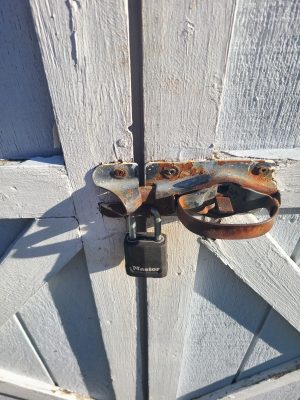By Heather Zidack, UConn Home & Garden Education Center

It’s already November! It doesn’t seem like that long ago when we were giving advice about seeding lawns and watering in new fall plantings. Now that the time has changed, the days feel shorter, and the nights are getting colder, it’s important to remember to take the time to properly store your garden equipment and accessories before locking up the shed for the season.
Freezing temperatures are on the way fast. Drain and roll up any hoses to remove tripping hazards from the landscape. Store them inside a garage or shed to keep them out of the elements and lengthen their lifespan of use in the garden. Make sure that your outdoor water systems are properly winterized. Whether that means flushing your irrigation system, or simply shutting off your outside water, don’t forget this important step to protect your pipes! Once lines are turned off, open external valves to relieve any remaining pressure.
Water can not only wreak havoc on pipes but many garden accessories, too. A glass rain gauge left outside can and will freeze and shatter outdoors. Ceramics like pottery and bird baths are susceptible to cracking, so store them either in the shed or upside down in a sheltered area. Stash your garden gnomes, garden flags and solar pathway lights to protect them from fading and damage. Brittle cold, freezing water, and a careless throw of the snow shovel could spell disaster for garden décor left out in the open.
Inside the shed, take a quick inventory. Leftover seed or bagged mulch could be rodent attractants. Seeds should be stored in areas safe from extreme temperatures to preserve germination rates. Bird seed should be stored in animal proof containers. Chemical products like pesticides and fertilizers may be adversely affected by temperature fluctuations and freezing. They could also make a real mess if a water-based or pressurized solution were to burst. Products leftover from the growing season should be evaluated and moved into a space safe from freezing temperatures. Product labels or manufacturers will have storage and disposal information to help you make the best decision about what to do with your garden chemicals at the end of the season.

Winter will be a great time to thoroughly clean, repair, and sharpen tools. Store them somewhere that is easy to get to later so you can make sure your tools are fresh for the new season! If you have to do the seasonal shed shuffle, this is also a great time to rotate the lawn mower and snow thrower to prepare for the first storms of the season.
Speaking of your gas-powered equipment, check your owner’s manuals for winterizing recommendations and instructions to help maintain the life and quality of your equipment. You may need specific maintenance before long term storage. Contact a professional for any maintenance tasks that you do not feel confident performing on your own.
If you’re running out of space in the shed and garage, consider covering lawn furniture with UV and mildew resistant covers. Take down awning covers and temporary structures. I, myself, have fallen victim to the false sense of security of a mild winter, only to be devastated by the collapse of my garden tent in the first, albeit belated, heavy snow.
While all of this seems like common sense, the mad dash from here to the holidays will have many of us pulled in different directions. Our equipment, tools, and garden infrastructure are some of the biggest investments we put into our gardens. Hopefully this short checklist will help you knock out those last few chores that come with maintaining a four season New England garden.
The UConn Home & Garden Education Center supports UConn Extension’s mission by providing answers you can trust with research-based information and resources. For gardening questions, contact us toll-free at (877) 486-6271, visit our website at homegarden.cahnr.uconn.edu, or reach out to your local UConn Extension center at extension.uconn.edu/locations.
This article was published in the Hartford Courant November 8, 2025